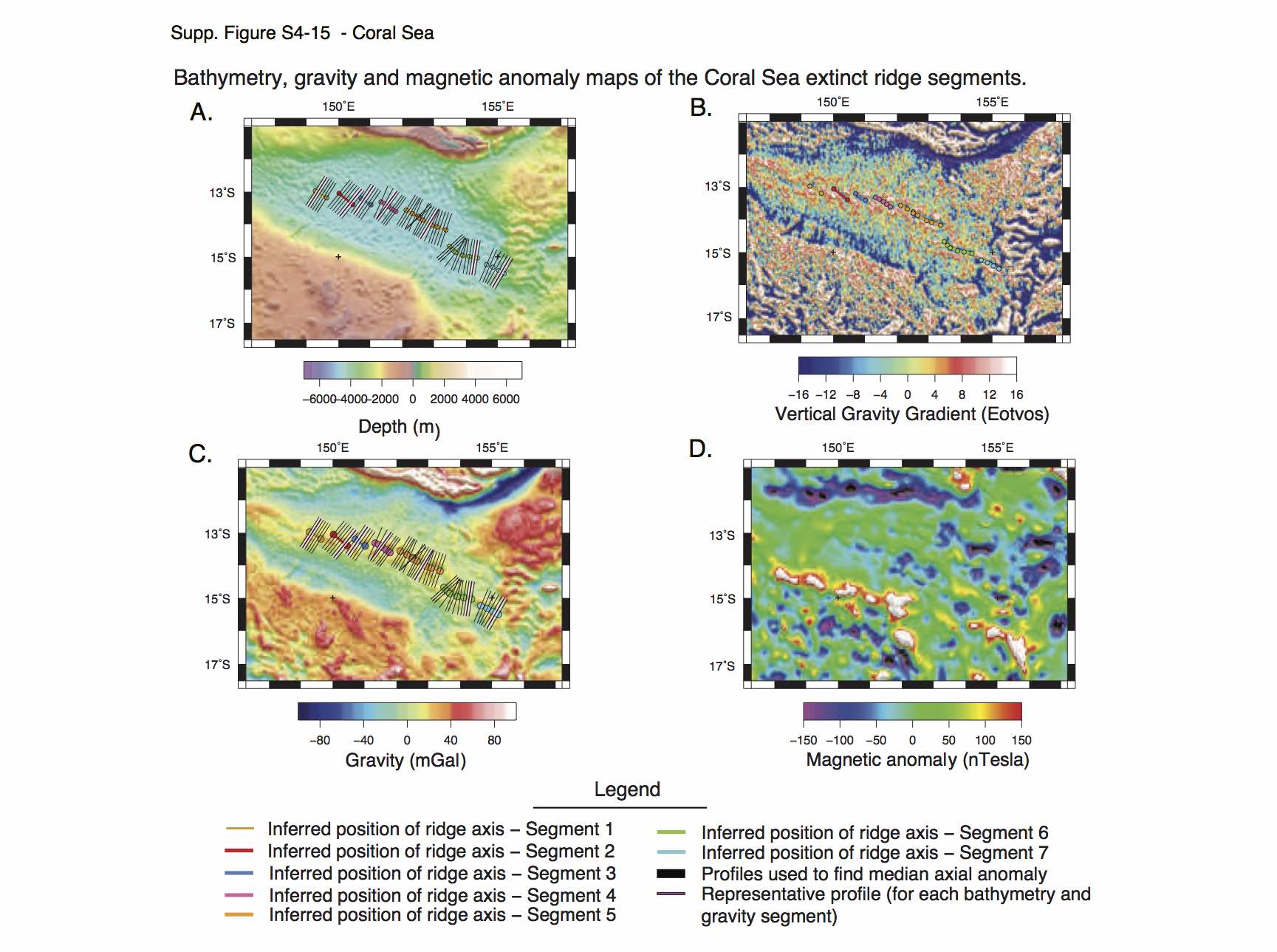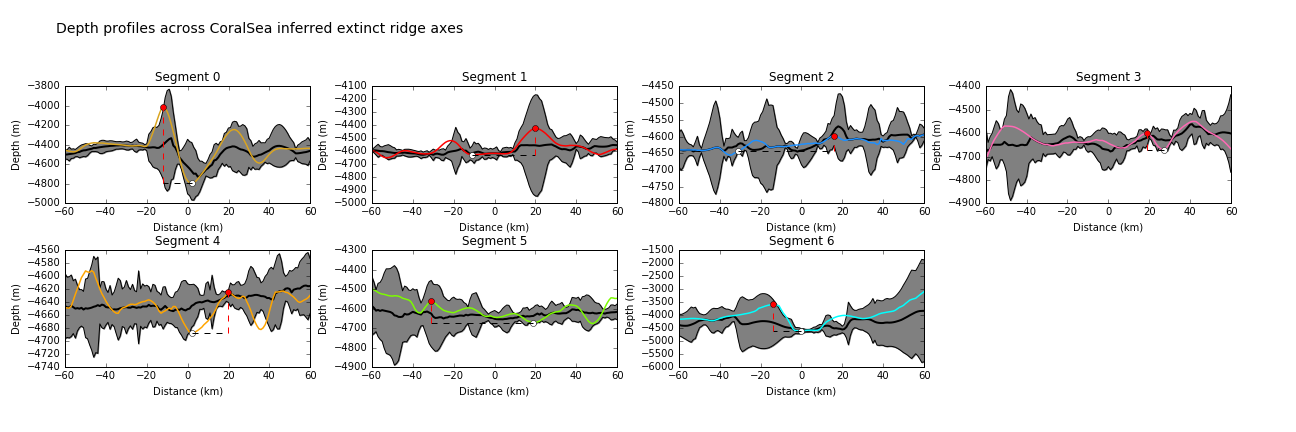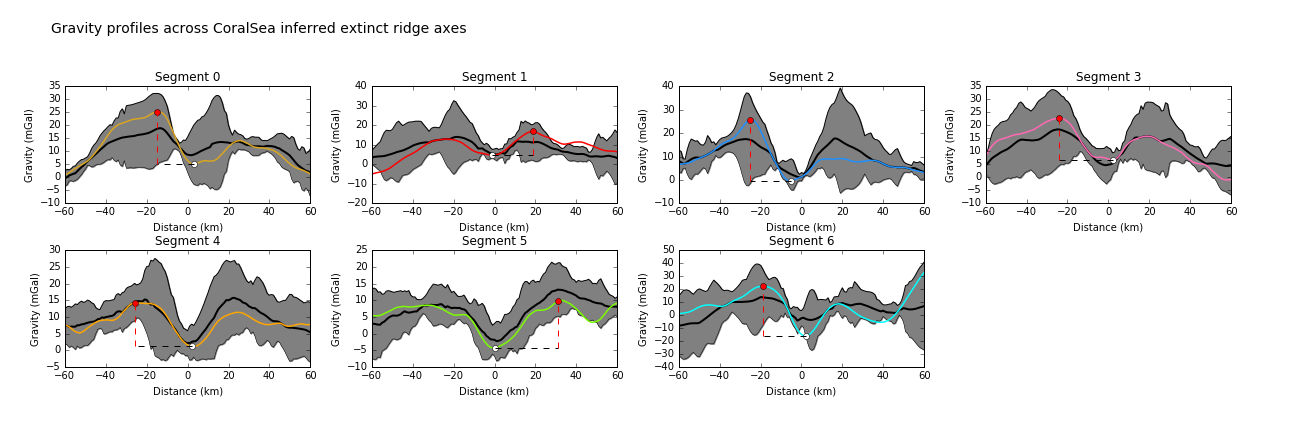| Ocean: | Marginal basin, western Pacific |
| Spreading center type: | Large-scale MOR |
| Time of cessation: | Ca. 52 Ma, chron C24o (Gaina et al., 1998) |
| Subsequent active spreading center: | None in immediate area |
The Coral Sea extinct spreading center was identified over 40 years ago following early marine surveys of the region (Ewing et al., 1970; Weissel and Watts, 1979). Ewing et al. (1970) proposed that the Queensland Plateau, adjacent to the Coral Sea, was underlain by thinned continental crust of the Australian plate extending to Papua New Guinea. The Coral Sea was observed to be anomalously shallow, with around 2.5 km thickness of accumulated sediments, and the basement was argued to be comprised of 'normal oceanic crust' (Ewing et al., 1970, p.1957). However, somewhat unusually, the basin was observed to have a clear positive long-wavelength gravity anomaly that is overlain by a short-wavelength negative anomaly at the ridge axis (Weissel and Watts, 1970), that may have been related to the submerged continental crust in the Queensland Plateau.
Weissel and Watts (1979) identified the magnetic anomalies within the Coral Sea, proposing that cessation ceased at chron C24 and measured the gravity field across the basin. The gravity anomaly signal at the extinct ridge is described as short wavelength (less than 40 km) and of between 10 and 20 mgals, with much longer wavelength, asymmetric gravity high also observed, with a wavelength around 350 km (Weissel and Watts 1979). The peak amplitude of the gravity high is on the eastern flank of the rift (ibid).
Weissel and Watts (1979) proposed that the Coral Sea may have been a failed third spreading limb from a triple point junction located between Australia, Papua New Guinea and the Louisiades, and the Lord Howe Rise, with the Tasman Sea spreading center providing another spreading limb, extending to the southeast. The inferred triple point junction (Weissel and Watts, 1979) required extension between Louisiade and the Lord Howe plateau to the east and it is proposed that the Tasman and Coral Seas ceased spreading at the same time ca. 56 Ma (chron C26). Unfortunately, the tectonic history to the northeast of the Coral Sea and particularly within the Hebrides Basin is more poorly understood (Seton et al., 2012) and it is difficult to confirm this theory.
Gaina et al. (1998) proposed that the Coral Sea spreading center was a continuation of the Tasman Sea axis, contrary to the argument from Weissel and Watts (1979) that the rotation parameters required for this 2-plate system were not equivalent between the Coral Sea and the Tasman Sea. Limited recent investigations or publications are available for the area, however, an international research cruise was undertaken in 2011 to collect geophysical data and dredge samples so it is hopeful that there will be publications forthcoming that help to improve knowledge of the crustal structure and evolution of the region.
Ewing, M., Hawkins, L. V. and Ludwig, W.J., 1970, Crustal structure of the Coral Sea, Journal of Geophysical Research, v. 75, no. 11, p. 1953-1962.
Gaina, C., Müller, R.D. and Royer, J.-Y., 1998, The tectonic history of the Tasman Sea: A puzzle with 13 pieces. Journal of Geophysical Research, v. 103, no. B6, p. 12,413–12,433.
Gaina, C., Müller, R. D., Royer, J-Y. and Symonds, P., 1999, Evolution of the Louisiade triple junction, Journal of Geophysical Research, v. 104, no. B6, p. 12,927-12,939.
Seton, M., Müller, R.D., Zahirovic, S., Gaina, C., Torsvik, T., Shephard, G., Talsma, A., Gurnis, M., Turner, M., Maus, S. and Chandler, M., 2012, Global continental and ocean basin reconstructions since 200Ma, Earth-Science Reviews, v. 113, no. 3-4, p. 212–270.
Weissel, J.K. and Watts, A.B., 1979, Evolution of the Coral Sea Basin, Journal of Geophysical Research, v. 84, no. B9, p. 4572–4582.


